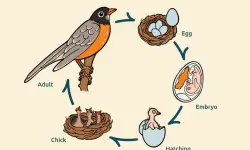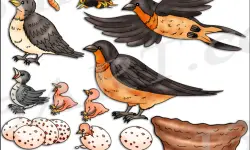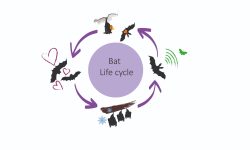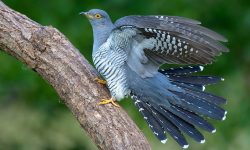Quail are small, ground-dwelling birds found throughout the Americas, admired for their charming calls, swift dashes through brush, and signature topknots. Despite their size, quail play a big role in ecosystems and are culturally important to hunting and conservation communities alike. In North America alone, there are 32 distinct species and subspecies, each with unique habitats, behaviors, and traits. Let’s explore these fascinating birds in detail.
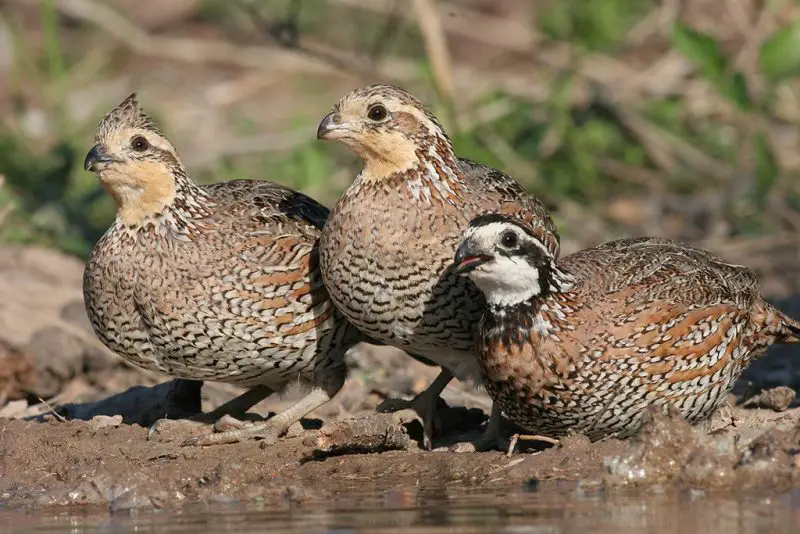
What Makes a Quail a Quail?
Small Game Birds with Distinctive Features
Quail belong to the family Odontophoridae in the Americas, distinct from Old World quail of the family Phasianidae. They are generally plump, short-tailed birds with powerful legs for scratching and running. Many American quail have head plumes or topknots and are more often heard than seen, thanks to their secretive nature.
Habitat and Distribution
American quail are native to a wide range of environments—from deserts and forests to grasslands and tropical hillsides. Some are highly localized, living in isolated mountain ranges or islands, while others are widespread across entire regions.
The Northern Bobwhite Complex
1. Northern Bobwhite (Colinus virginianus)
Distribution: Eastern and central United States, parts of Mexico and the Caribbean.
Appearance: A small, plump bird with a short tail, males have a white throat and eyebrow bordered by black, while females are duller with buff-colored markings.
Habitat: Open fields, brushy areas, farmlands, and pine savannas.
Call: A distinctive, clear whistle that sounds like “bob-WHITE.”
Breeding: Ground nests hidden in grass; clutches of 12–16 eggs; both sexes may care for young.
Conservation: Declining in many areas due to habitat loss and modern agriculture.
2. Masked Bobwhite (Colinus virginianus ridgwayi)
Distribution: Historically southern Arizona and northern Sonora, Mexico.
Appearance: Similar to Northern Bobwhite but males have a striking black face and throat with reddish breast.
Habitat: Desert grasslands with mesquite cover.
Call: Similar to Northern Bobwhite but softer and less frequent.
Breeding: Nests on the ground; population once extinct in the wild but under active reintroduction.
Conservation: Critically endangered; intensive breeding and habitat restoration underway.
3. Florida Bobwhite (Colinus virginianus floridanus)
Distribution: Peninsular Florida.
Appearance: Slightly smaller, with more rufous coloring than the nominate species.
Habitat: Pine flatwoods, palmetto scrub, and agricultural edges.
Conservation: Stable in protected areas but vulnerable to urban sprawl.
4. Texas Bobwhite (Colinus virginianus texanus)
Distribution: South-central Texas and adjacent Mexico.
Appearance: Richer brown tones, well adapted to hot, dry brushland.
Habitat: Mesquite brush, thornscrub, and ranchlands.
Conservation: Managed on many private lands for hunting; stable in some areas.
5. Plains Bobwhite (Colinus virginianus taylori)
Distribution: Great Plains from Kansas south into Oklahoma and northern Texas.
Appearance: Paler overall, well camouflaged in dry grasslands.
Habitat: Tallgrass and mixed-grass prairies.
Conservation: Declining with prairie loss.
6. Mexican Bobwhite (Colinus virginianus mexicanus)
Distribution: Eastern Mexico from Tamaulipas southward.
Appearance: Similar to nominate but with darker plumage and longer tail.
Habitat: Thorn forests and grassy hillsides.
Conservation: Little studied; presumed stable in suitable areas.
7. Gulf Coast Bobwhite (Colinus virginianus saturatus)
Distribution: Coastal Louisiana and Mississippi.
Appearance: Darker, more saturated coloration; well adapted to humid pine flatwoods.
Habitat: Pine savannas, marsh edges, and coastal scrub.
Conservation: Affected by wetland loss and development.
8. Cuban Bobwhite (Colinus virginianus cubanensis)
Distribution: Cuba and Isla de la Juventud.
Appearance: Island subspecies, stockier build, paler throat markings.
Habitat: Agricultural fields, brushlands, and low forests.
Conservation: Stable in rural Cuba; not under major threat.
9. Black-headed Bobwhite (Colinus nigrogularis)
Distribution: Yucatán Peninsula, northern Central America.
Appearance: Striking black head, throat, and breast with white streaking.
Habitat: Lowland dry forests, savannas, and secondary scrub.
Call: Harsh, chattering notes rather than the whistle of C. virginianus.
Conservation: Widespread in its range but declining in deforested areas.
10. Spot-bellied Bobwhite (Colinus leucopogon)
Distribution: Pacific lowlands of Central America.
Appearance: Pale face, rufous flanks, and white belly with dark spots.
Habitat: Scrubland, agricultural edges, and second-growth forests.
Conservation: Generally uncommon, localized in suitable habitats.
11. Yucatán Bobwhite (Colinus nigrogularis perspicillatus)
Distribution: Northern Yucatán Peninsula.
Appearance: A subspecies of Black-headed Bobwhite with subtle facial differences.
Habitat: Tropical dry scrub and savanna mosaics.
Conservation: Limited range but not immediately threatened.
California Quail and Allies
12. California Quail (Callipepla californica)
Distribution: West Coast of the United States, including California, Oregon, and parts of Washington and British Columbia. Introduced to Hawaii, Chile, and New Zealand.
Appearance: Plump, with a prominent forward-curving black topknot (plume). Males have a scaled belly, chestnut flanks, and black-and-white facial markings.
Habitat: Chaparral, oak woodlands, suburban gardens, and coastal scrub.
Call: A distinctive “chi-CA-go” call, often repeated.
Breeding: Builds ground nests concealed in grass; lays 12–16 eggs; chicks are precocial.
Conservation: Common and stable, often seen in urban parks and gardens.
13. Gambel’s Quail (Callipepla gambelii)
Distribution: Southwestern U.S. including Arizona, New Mexico, southern Nevada, and parts of California; also found in northern Mexico.
Appearance: Males have a black face and bib, chestnut crown, and gray body with a teardrop-shaped topknot.
Habitat: Desert scrub, mesquite thickets, and arid canyons.
Call: Loud “ka-KAA-ka” and whistling contact calls within coveys.
Breeding: Nesting begins early in spring; eggs often laid in shallow depressions beneath shrubs or cactus.
Conservation: Abundant in many desert areas but affected by prolonged droughts and habitat fragmentation.
14. Scaled Quail (Callipepla squamata)
Distribution: Southwestern U.S., particularly in New Mexico, west Texas, and eastern Arizona, as well as northern Mexico.
Appearance: Named for the scaly appearance of its gray-blue feathers. Has a white-tufted crest resembling a cotton ball.
Habitat: Arid grasslands, open plains, and mesquite flats.
Call: A scratchy “whock-whock-whock” call; covey calls include short clucks and chirps.
Breeding: Ground nests are camouflaged; females incubate 9–16 eggs.
Conservation: Populations fluctuate with rainfall; droughts can reduce breeding success significantly.
15. Elegant Quail (Callipepla douglasii)
Distribution: Endemic to western Mexico, particularly in the states of Sinaloa, Nayarit, and Jalisco.
Appearance: Striking quail with olive-green upperparts, white spots on flanks, and a bushy, black topknot. Males are more vividly colored than females.
Habitat: Tropical deciduous forests, scrub, and hilly terrain with dense undergrowth.
Call: A series of melodious whistles; often more musical than other Callipepla.
Breeding: Little is known about their nesting habits, but similar to other quails in nesting on the ground.
Conservation: Localized but not globally threatened; their range includes protected areas.
Montezuma Quail and Relatives
16. Montezuma Quail (Cyrtonyx montezumae)
Distribution: Pine-oak woodlands in Arizona, New Mexico, west Texas, and highland regions of Mexico.
Appearance: A rotund quail with striking black-and-white facial pattern, scaly flanks, and buff underparts. Males have a dramatic face mask and chestnut back.
Habitat: Grassy understory in montane oak and pine forests, often at 5,000–8,000 feet elevation.
Call: Quiet and ventriloquial; often a series of soft whistling notes.
Breeding: Secretive ground nests under grass clumps; lays 6–12 eggs; highly elusive during nesting season.
Conservation: Populations stable in undisturbed highland areas but declining where forests are grazed or logged.
17. Spot-bellied Bobwhite (Colinus leucopogon)
Distribution: Southern Mexico through Central America to western Panama.
Appearance: A medium-sized quail with white-spotted belly, buffy flanks, and mottled brown back. Less contrasty facial pattern than Northern Bobwhite.
Habitat: Open forests, savannas, and edges of agricultural land.
Call: Variable, including rapid piping notes and rolling whistles.
Breeding: Builds shallow nests on the ground; little studied due to secretive nature.
Conservation: Widespread but uncommon; habitat destruction in Central America is a growing threat.
Tropical Quail of Central and South America
18. Singing Quail (Dactylortyx thoracicus)
Distribution: Southeastern Mexico through Guatemala, Honduras, and Nicaragua.
Appearance: A medium-sized quail with rufous flanks, brown mottled back, and buff face. Males have a dark throat patch.
Habitat: Moist cloud forests, tropical foothills, and montane pine-oak forests.
Call: Complex, melodic duets sung between pairs, often with long, whistled notes followed by trills.
Breeding: Nests on the forest floor in dense underbrush; monogamous pairs defend territories.
Conservation: Locally common but threatened by deforestation in highland areas.
19. Tawny-faced Quail (Rhynchortyx cinctus)
Distribution: Lowland rainforests of Costa Rica, Panama, Colombia, and northwestern Ecuador.
Appearance: A slender-bodied quail with olive-brown upperparts, tawny face, and grayish chest.
Habitat: Humid tropical forest interiors; prefers dense understory near streams.
Call: A sharp, nasal “kweet” repeated at intervals; more often heard than seen.
Breeding: Nests are extremely rare in the wild; likely ground-nesting like other quails.
Conservation: Habitat-specific and uncommon; vulnerable to rainforest clearing.
The Wood Quail (Genus Odontophorus)
Wood Quail are elusive, ground-dwelling birds of tropical forests stretching from southern Mexico to northern South America. Most are secretive, traveling in small coveys and rarely seen in open. Here are twelve recognized species.
20. Gorgeted Wood Quail (Odontophorus strophium)
Distribution: Endemic to Colombia’s Andean foothills.
Appearance: Brownish body with distinctive white-and-black gorget across the throat.
Habitat: Cloud forests and subtropical montane forest edges.
Call: Harsh duets between mates, often a rising whistle followed by a rapid chatter.
Conservation: Critically endangered due to habitat loss and fragmentation.
21. Black-fronted Wood Quail (Odontophorus atrifrons)
Distribution: Andes of Colombia and western Venezuela.
Appearance: Males have a solid black face and front with reddish-brown body.
Habitat: Dense montane forests and bamboo thickets.
Conservation: Vulnerable; populations fragmented by agriculture and logging.
22. Rufous-fronted Wood Quail (Odontophorus erythrops)
Distribution: Western Ecuador and southwestern Colombia.
Appearance: Rich rufous head and chest with barred underparts.
Habitat: Foothill rainforests and wet slopes.
Conservation: Near-threatened due to rapid deforestation in its limited range.
23. Chestnut Wood Quail (Odontophorus hyperythrus)
Distribution: Highlands of Colombia.
Appearance: Deep chestnut plumage with a darker crown and face.
Habitat: Montane humid forests above 2000 m.
Conservation: Endemic and little-studied; presumed at risk from deforestation.
24. Dark-backed Wood Quail (Odontophorus melanonotus)
Distribution: Pacific slopes of Ecuador.
Appearance: Dark sooty back and wings, with lighter belly.
Habitat: Dense lowland and foothill rainforests.
Conservation: One of the least known species; data deficient.
25. Venezuelan Wood Quail (Odontophorus columbianus)
Distribution: Endemic to northern Venezuela.
Appearance: Uniform brown with subtle facial markings.
Habitat: Isolated montane forests.
Conservation: Endangered; habitat degradation is a major threat.
26. Black-breasted Wood Quail (Odontophorus leucolaemus)
Distribution: Costa Rica and western Panama.
Appearance: Black breast and face with chestnut flanks.
Habitat: Montane cloud forests and oak forests.
Conservation: Stable in some protected areas, but highly sensitive to disturbance.
27. Marbled Wood Quail (Odontophorus gujanensis)
Distribution: Widespread in Amazon Basin, including Brazil, Peru, and Ecuador.
Appearance: Mottled brown and black plumage that camouflages in forest floor leaf litter.
Habitat: Lowland tropical rainforests.
Call: Loud, rhythmic whistles often heard at dawn.
Conservation: Still common in parts of the Amazon but declining at forest edges.
28. Starred Wood Quail (Odontophorus stellatus)
Distribution: Southern Amazon regions of Brazil, Bolivia, and Paraguay.
Appearance: Black face and throat with white “star” spotting across the chest.
Habitat: Lowland and foothill rainforest with dense undergrowth.
Conservation: Patchily distributed; vulnerable to forest fragmentation.
29. Stripe-faced Wood Quail (Odontophorus balliviani)
Distribution: Eastern slopes of the Andes in Peru and Bolivia.
Appearance: Reddish with prominent white stripe behind the eye and a darker crown.
Habitat: Moist montane forests.
Conservation: Poorly known; likely declining due to logging and slash-and-burn farming.
30. Tacarcuna Wood Quail (Odontophorus dialeucos)
Distribution: Restricted to the Tacarcuna Ridge between Panama and Colombia.
Appearance: Black throat, white belly, and dark upperparts.
Habitat: Cloud forests in remote mountainous areas.
Conservation: Extremely limited range; threatened by mining and illegal logging.
31. Spotted Wood Quail (Odontophorus guttatus)
Distribution: Central America from southern Mexico to Panama.
Appearance: Brownish body with white spots and a streaked crown.
Habitat: Humid lowland forests and hill forests.
Call: Loud series of cackles and whistles in the early morning.
Conservation: Fairly common in some regions; declining in areas of logging.
32. Buff-throated Wood Quail (Odontophorus speciosus)
Distribution: Andes of southern Peru and northern Bolivia.
Appearance: Buff throat, rufous back, and spotted flanks.
Habitat: Montane cloud forests.
Conservation: Rare and very poorly studied; likely threatened by ongoing habitat degradation.
Conclusion
From the grassy plains of the Midwest to the misty cloud forests of the Andes, quail have carved out a place in nearly every corner of the American landscape. With 32 species and subspecies spread across North, Central, and South America, these small but remarkable birds reveal a hidden richness in avian diversity. Some, like the Northern Bobwhite and California Quail, are familiar and beloved icons of countryside life. Others—shy Wood Quail skulking through shadowy rainforests—remain mysterious, even to science.
Yet across their range, quail face mounting challenges. Habitat loss, climate change, and land degradation threaten even the most common populations. For the more elusive species with narrow ranges, the danger is urgent. But with informed conservation efforts, habitat restoration, and public awareness, we can help ensure that these birds continue to thrive—not just in scientific checklists, but in living ecosystems.
Whether you’re a seasoned birder or a curious nature lover, learning to recognize the soft whir of wings in the underbrush or the far-off whistle of a bobwhite can transform the way you see the natural world. Quail are more than game birds or ground dwellers—they are storytellers of habitat, history, and resilience.
Keep your eyes low, your ears open, and your heart curious—because the next rustle in the grass might be one of America’s most enchanting little secrets.

